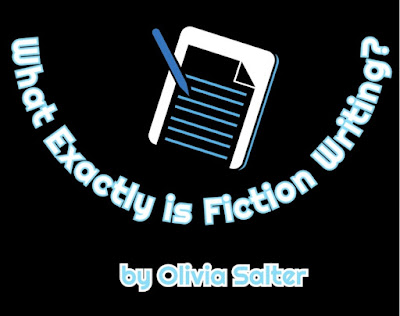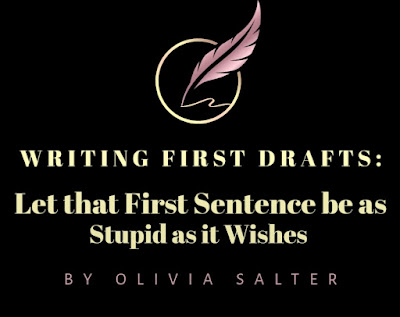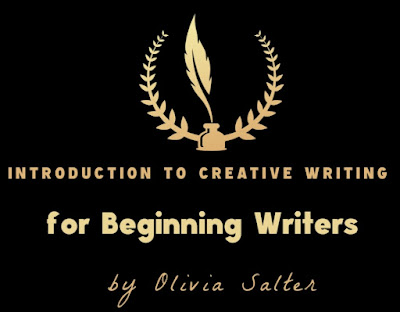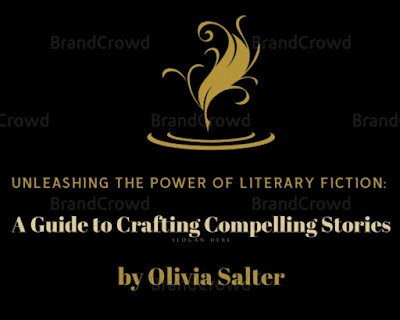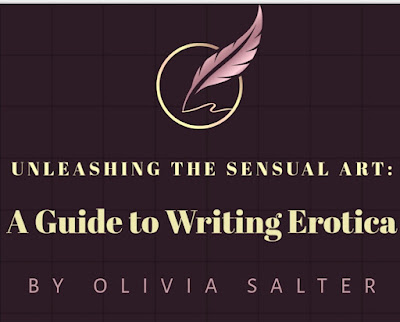Introduction to Creative Writing for Beginning Writers
by Olivia Salter
Lesson Overview:
In this lesson, we will explore the fundamentals of creative writing for aspiring writers who are just starting their journey. We will cover essential elements such as developing imagination, creating engaging characters, crafting vivid settings, and constructing compelling narratives. By the end of this lesson, you will have a basic understanding of the key principles of creative writing to help kickstart your writing endeavors. I have compiled the 7 lessons for your convenience.
Lesson Outline:
1. Introduction to Creative Writing:
a. Definition and purpose of creative writing.
b. Benefits of creative writing.
2. Developing Imagination:
a. Importance of imagination in creative writing.
b. Techniques to enhance imagination:
i. Mind mapping.
ii. Freewriting.
iii. Visual stimuli.
3. Creating Engaging Characters:
a. The role of characters in storytelling.
b. Techniques for character development:
i. Physical appearance.
ii. Personality traits.
iii. Background and motivations.
4. Crafting Vivid Settings:
a. Importance of setting in creative writing.
b. Techniques for describing settings:
i. Sensory details.
ii. Use of metaphors and similes.
iii. Nurturing reader's imagination.
5. Constructing Compelling Narratives:
a. Basics of narrative structure:
i. Introduction.
ii. Rising action.
iii. Climax.
iv. Falling action.
v. Resolution.
b. Techniques to make narratives engaging:
i. Conflict and tension.
ii. Dialogue.
iii. Pacing.
6. Exercise: Imaginative Writing Prompt:
a. Provide a writing prompt to practice the concepts covered in the lesson.
b. Encourage creativity and experimentation.
7. Conclusion:
a. Recap of key points covered.
b. Encouragement to continue practicing and exploring creative writing.
Notes to the Instructor:
- Encourage students to actively participate in discussions and share their ideas.
- Provide feedback on student assignments to foster improvement.
- Suggest additional resources for further exploration into creative writing techniques.
Remember, creative writing is a skill that grows with practice. Be patient with yourself and enjoy the process of exploring new worlds through your imagination.
Theory: Introduction to Creative Writing
1. Introduction to Creative Writing
Creative writing is a captivating and expressive form of writing that allows individuals to explore their thoughts, ideas, and emotions in a unique and artistic way. It goes beyond the boundaries of formal writing and encourages individuals to tap into their creativity and imagination. Whether you are an aspiring novelist, poet, or simply someone looking to express themselves more creatively, creative writing can open up a world of possibilities.
So, what exactly is creative writing? At its core, creative writing is the art of using words to create original and imaginative literary works. Unlike technical or academic writing, creative writing focuses on self-expression, storytelling, and evoking emotions. It invites readers on a journey, transports them to different worlds, or allows them to experience life through a different lens.
The purpose of creative writing can vary from person to person. Some writers write to entertain, to captivate an audience, and to leave them spellbound by the power of their words. Others use it as a form of therapy, a way to process their thoughts and emotions, or to find solace in difficult times. No matter the purpose, creative writing offers a medium for self-discovery, personal growth, and connection with others.
Engaging in creative writing can bring forth a plethora of benefits. Firstly, it helps improve communication skills as writers learn to effectively convey their ideas, thoughts, and emotions to their readers. It also enhances cognitive abilities, such as critical thinking, problem-solving, and analytical skills, as writers navigate the complexities of constructing narratives and developing engaging characters.
Furthermore, creative writing fosters empathy and understanding. Through exploring diverse perspectives and experiencing the world through the eyes of different characters, writers develop a deeper sense of compassion and tolerance. It enables individuals to connect with others on a deeper level, transcending cultural, social, and linguistic barriers.
Additionally, creative writing serves as an outlet for self-expression and boosts personal confidence. It encourages individuals to trust their own voice and ideas, promoting a sense of authenticity and self-assurance. The act of creating something from scratch and seeing it come to life on the page is immensely empowering.
Creative writing also cultivates the ability to think outside the box and embrace innovation. As writers continually challenge themselves to explore new ideas, settings, and perspectives, they develop a sense of adaptability and creativity that can be applied in various aspects of life.
To embark on your creative writing journey, it's important to remember that this skill grows with practice. Be patient with yourself, allow your imagination to run wild, and embrace the process of discovery. There are countless resources available to further explore creative writing techniques, such as writing workshops, online courses, and books. In conclusion, creative writing is a powerful tool that allows individuals to unleash their creativity and imagination. It offers a platform for self-expression, personal growth, and connection with others. By delving into the world of creative writing, you can unlock new possibilities, open doors to limitless storytelling, and embark on a remarkable journey of self-discovery. So, pick up your pen, let your thoughts flow, and get ready to create magic with words.
2. Developing Imagination
Introduction:
Imagination is a powerful tool that allows us to explore the depths of our creativity and bring our thoughts to life through words. In the world of creative writing, it plays a crucial role in crafting compelling narratives, captivating characters, and immersive settings. By developing imagination, writers can unlock endless possibilities, create unique storylines, and take their readers on extraordinary journeys. In this article, we will delve into the importance of imagination in creative writing and explore various techniques to enhance and nurture this vital skill.
The Importance of Imagination in Creative Writing:
Imagination serves as the backbone of creative writing, breathing life into ideas and transforming them into captivating stories. Here are a few reasons why imagination is so important in the realm of creative writing:
1. Crafting Unique Stories: Imagination allows writers to think beyond the ordinary and create unique narratives that captivate readers. It helps in developing original plots and complex characters, engaging readers in different worlds, and immersing them in richly detailed settings. Imagination enables authors to paint visual pictures with words, evoking emotions and ensuring readers are fully engrossed in the story.
2. Making Characters Come Alive: Imagination enables writers to develop relatable and multidimensional characters. By envisioning their thoughts, desires, and quirks, writers can breathe life into these characters, making them more relatable and memorable for readers.
3. Encouraging Exploration and Innovation: Imagination encourages writers to explore unconventional ideas, experiment with different genres, and push the boundaries of creativity. It provides the freedom to think outside the box, resulting in fresh and innovative storytelling.
Techniques to Enhance Imagination:
1. Mind Mapping: Mind mapping is a technique that allows writers to visualize their ideas and expand upon them. Start by writing a central idea or theme in the center of a piece of paper, then branch out with related sub-ideas, characters, settings, and plot points. This technique helps stimulate the imagination by exploring various connections and possibilities.
2. Freewriting: Freewriting is a valuable exercise to unleash the power of imagination. Set a timer for 10–15 minutes and write continuously without any restrictions or judgment. This process allows thoughts to flow freely and encourages new ideas to surface, fostering creativity and imagination.
3. Visual stimuli: Engaging with visual stimuli can awaken the imagination and inspire unique ideas. Look at paintings, photographs, or movies that evoke strong emotions or capture your interest. The visuals will act as a catalyst and trigger fresh perspectives, allowing you to incorporate new elements into your writing.
Conclusion:
Imagination is the fuel that drives the engine of creative writing. By nurturing this powerful skill, writers can unlock their full potential, break through creative blocks, and embark on remarkable journeys of self-discovery. The techniques mentioned above, such as mind mapping, freewriting, and engaging with visual stimuli, can help writers enhance their imagination and take their storytelling to new heights. So, pick up your pen, let your thoughts roam free, and unleash the magic that lies within the realm of imagination. Happy writing!
3. Creating Engaging Characters
Characters play a pivotal role in storytelling, acting as the backbone upon which the narrative unfolds. They are the vehicles through which readers immerse themselves in the fictional world, forming connections and investing emotionally in the unfolding events. An engaging character can captivate readers and leave a lasting impression, making them yearn for more. So, how can writers create characters that resonate with their audience? Let's explore the techniques for character development that can bring your creations to life.
1. Physical Appearance:
Intriguing characters often possess unique physical attributes that make them stand out from the crowd. Whether it's an iconic hairstyle, distinctive clothing, or even a scar, these defining features help readers visualize the character and set them apart from others. Additionally, paying attention to details like body language and gestures can add depth to the character, making them more relatable and realistic. Descriptive passages that highlight these physical traits evoke vivid imagery and immerse readers in a range of personality traits. These traits shape their behavior, reactions, and interactions with other characters, driving the plot forward. For example, a protagonist who is brave but also impulsive might find themselves in dangerous situations due to their recklessness. Exploring both positive and negative aspects of a character's personality adds depth, complexity, and authenticity, making them more relatable to readers.
2. Background and Motivations:
Every character has a past that shapes their present and future. Delving into a character's background allows writers to understand their motivations, desires, and fears. This insight enriches the storytelling experience by providing context and explaining the character's actions. Consider exploring their childhood, upbringing, and pivotal life events that have influenced their decisions, beliefs, and relationships. Crafting a compelling backstory helps readers connect with the character on a deeper level, rendering them multi-dimensional and relatable.
However, it's crucial to strike a balance between revealing character details and leaving room for readers' interpretation. Providing hints and clues throughout the story can pique curiosity and engage readers as they try to unravel the complexities of the character's past.
In conclusion, creating engaging characters is an art that requires writers to tap into the limitless realm of imagination. By incorporating physical appearance, personality traits, and background into their character development process, writers can breathe life into their creations. These techniques foster emotional connections between readers and characters, making the storytelling experience more enchanting and immersive. So, let your imagination run wild and embark on a journey to create characters that leave an indelible mark on the hearts and minds of your readers. Happy writing!
4. Crafting Vivid Settings
Your Story to Life
When it comes to creative writing, the setting holds immense importance, immersing them in the world of your story. A well-crafted setting can transport readers to different times, places, and even realities, making the storytelling experience more enchanting and immersive. So, let your characters leave an indelible mark on the hearts and minds of your readers. Happy writing!
The Importance of Setting in Creative Writing:
The setting serves as the backdrop against which your story unfolds. It not only provides a sense of place but also sets the tone, atmosphere, and mood of your narrative. The way you describe your setting can make your readers feel as if they are walking alongside your characters, experiencing every sight, sound, and scent with them.
A well-developed setting adds depth and richness to your story, making it come alive in the reader's mind. Whether it is a bustling city, a cozy cottage in the woods, or an alien planet, the setting should be vividly depicted to evoke emotions, enhance the plot, and create a memorable reading experience.
Techniques for Describing Settings:
To create a vivid setting, utilize techniques that engage the reader's senses, ignite their imagination, and foster a strong connection between the fictional world and reality. Here are some techniques to consider:
1. Sensory Details:
Incorporate sensory details by using descriptive language that appeals to the five senses: sight, sound, smell, taste, and touch. Instead of simply saying "the room was beautiful," paint a picture in the reader's mind by describing the rich, earthy scent of freshly brewed coffee, the soft warmth of sunlight streaming through the window, or the distant sound of laughter echoing through the air.
2. Use of Metaphors and Similes:
Metaphors and similes can be powerful tools for enhancing your descriptions. By comparing elements of the setting to something familiar or using figurative language, you can create a deeper understanding and emotional connection for readers. For example, instead of describing a storm as "loud," you could say it was like "a roaring beast, shaking the earth with its furious cries."
3. Nurturing the Reader's Imagination:
While it is important to provide detailed descriptions, leave room for the reader's imagination to fill in the gaps. Give them just enough information to form a mental image, but allow their own creativity to take flight. This way, they become active participants in the story, co-creating the setting alongside you.
Remember, every word you choose to describe the setting should serve a purpose. It should enhance the mood, reveal character traits, or progress the plot. Be intentional in selecting details that are relevant and evocative, rather than overwhelming readers with unnecessary information.
In conclusion, crafting vivid settings is a crucial aspect of creative writing. The setting impacts how readers engage with your story, making it essential to provide sensory details, use metaphors and similes, and nurture the reader's imagination. By following these techniques, your settings will come alive, creating a world that readers won't want to leave. So, grab your pen, unleash your creativity, and transport your readers to places they've never been before. Happy writing!
5. Constructing Compelling Narratives
Writing a captivating narrative is an art that can transport readers to different worlds, evoke emotions, and leave a lasting impact. To create a narrative that readers won't want to leave, it is essential to master the basics of narrative structure and employ various techniques to make the story engaging. In this article, we will explore the fundamentals of narrative structure and discuss techniques that can make your narratives truly compelling.
a. Basics of narrative structure:
i. Introduction: The introduction sets the stage for the story, introducing the characters, the setting, and the initial conflict or problem that will drive the narrative forward. It is crucial to grab the reader's attention and establish the tone and atmosphere of the story from the very beginning.
ii. Rising action: The rising action builds upon the introduction, presenting challenges, obstacles, and conflicts that the characters must face. This section of the narrative should steadily increase tension, drawing the reader deeper into the story and creating a sense of anticipation for what is to come.
iii. Climax: The climax is the turning point of the story, where the main conflict reaches its peak. It is the most intense and dramatic moment that determines the ultimate outcome of the narrative. The climax should be a powerful culmination of the rising action, leaving the reader on the edge of their seat.
iv. Falling action: Following the climax, the falling action provides a resolution to the conflicts introduced earlier in the story. It eases the tension and begins to wrap up loose ends, leading the reader towards the conclusion of the narrative. The falling action allows the reader to process and reflect on the events that have transpired.
v. Resolution: The resolution is the final part of the narrative, where all loose ends are tied up and the story comes to a satisfying conclusion. It should provide closure for the reader, answer any remaining questions, and offer a sense of fulfillment.
b. Techniques to make narratives engaging:
i. Conflict and tension: Conflict is the driving force of any narrative and is essential to keeping readers engaged. Introduce internal or external conflicts that challenge the characters and create tension throughout the story. Conflict adds depth to the characters and propels the narrative forward, ensuring readers remain invested.
ii. Dialogue: Well-crafted dialogue can bring characters to life and create a sense of authenticity within the narrative. Use dialogue to reveal character traits, advance the plot, and convey emotions. Make sure the conversations are natural and contribute to the overall development of the story.
iii. Pacing: Pacing refers to the rhythm and tempo of the narrative. Varying the pace can heighten tension, build suspense, or allow for moments of reflection. By strategically controlling the speed at which events unfold, you can maintain reader interest and create a dynamic reading experience.
In conclusion, constructing compelling narratives involves mastering the fundamentals of narrative structure and utilizing techniques that make the story engaging. By carefully combining action, climax, falling action, and resolution, you can create a solid structure for your narrative. Additionally, incorporating conflict and tension, well-crafted dialogue, and effective pacing will elevate your storytelling and keep readers captivated till the very end. So, grab your pen, unleash your creativity, and transport your readers to places they've never been before. Happy writing!
6. Exercise: Imaginative Writing Prompt
Here are two writing prompts to inspire your imaginative writing:
1. Write a story about a character who wakes up one morning with the ability to hear other people's thoughts. How does this newfound power impact their daily lives? Explore the challenges they face, the secrets they uncover, and the relationships they form as a result.
2. Imagine a world where time travel is possible. Write a short story about a group of friends who stumble upon a hidden time portal. Where does the portal lead them, and what adventures do they encounter in the past or future? How does their journey change them and their perspectives on life?
Remember, these prompts are just the starting point. Feel free to let your imagination run wild, add unique twists, and explore different genres or styles of writing. Happy writing!
7. Conclusion
a. Its time to recap all key points covered in 1-5.
1. Introduction to Creative Writing
Creative writing is an artistic and expressive form of writing that allows individuals to express their thoughts, ideas, and emotions in a unique and artistic way. It goes beyond formal writing and encourages individuals to tap into their creativity and imagination. Creative writing can serve various purposes, such as entertainment, therapy, or personal growth. It improves communication skills, enhances cognitive abilities, fosters empathy, and boosts personal confidence. It also encourages thinking outside the box and embraces innovation.
To embark on a creative writing journey, it is important to be patient, allow imagination to run wild, and embrace the process of discovery. Resources such as writing workshops, online courses, and books can help further explore creative writing techniques. By delving into the world of creative writing, individuals can unlock new possibilities, open doors to limitless storytelling, and embark on a remarkable journey of self-discovery.
2. Developing Imagination
Imagination is a vital skill in creative writing, allowing writers to create compelling narratives, captivating characters, and immersive settings. It plays a crucial role in crafting unique stories, making characters come alive, and encouraging exploration and innovation. Techniques to enhance imagination include mind mapping, freewriting, and engaging with visual stimuli. Mind mapping involves visualizing ideas and expanding upon them, while freewriting allows thoughts to flow freely and encourages new ideas to surface. Visual stimuli, such as paintings, photographs, or movies, can awaken the imagination and inspire unique ideas. By nurturing imagination, writers can unlock their full potential, break through creative blocks, and embark on remarkable journeys of self-discovery. By incorporating these techniques, writers can take their storytelling to new heights and unleash the magic that lies within the realm of imagination.
3. Creating Engaging Characters
Characters are essential in storytelling, as they help readers immerse themselves in the story and form emotional connections. To create engaging characters, writers can use techniques such as physical appearance, personality traits, and background. Physical attributes, such as hairstyles, clothing, and scars, help readers visualize the character and make them more relatable. Personality traits, such as braveness and impulsivity, shape the character's behavior and interactions. Understanding the character's background and motivations helps provide context and explain their actions. Balancing revealing details with allowing readers to interpret is crucial. By incorporating these techniques, writers can create characters that leave a lasting impression on readers and make the storytelling experience more immersive.
4. Crafting Vivid Settings
Crafting vivid settings is crucial in creative writing, as it transports readers to different times, places, and realities, making the storytelling experience more enchanting and immersive. The setting serves as the backdrop against which the story unfolds, providing a sense of place and setting the tone, atmosphere, and mood of the narrative. Techniques for describing settings include incorporating sensory details, using metaphors and similes, and nurturing the reader's imagination. Sensory details involve using descriptive language that appeals to the five senses: sight, sound, smell, taste, and touch. Metaphors and similes can be powerful tools for enhancing descriptions by comparing elements of the setting to familiar or figurative language. Nurturing the reader's imagination allows them to fill in gaps, becoming active participants in the story. In conclusion, crafting vivid settings is essential for engaging readers and creating a world that they will never want to leave.
5. Constructing Compelling Narratives
Compelling narratives are an art that transports readers to different worlds, evokes emotions, and leaves a lasting impact. Mastering the basics of narrative structure and employing techniques to make the story engaging are essential. The basic elements of narrative structure include the introduction, which sets the stage for the story, the rising action, which presents challenges and conflicts, the climax, which is the turning point, the falling action, which provides a resolution to the conflicts, and the resolution, which provides closure and answers any remaining questions.
To make narratives engaging, conflict and tension are essential, as they add depth to the characters and propel the narrative forward. Well-crafted dialogue can bring characters to life and create a sense of authenticity. Pacing, which refers to the rhythm and tempo of the narrative, can heighten tension, build suspense, or allow for moments of reflection. By carefully combining action, climax, falling action, and resolution, a solid structure can be created, ensuring a captivating and engaging story.
b. Encouragement to continue practicing and exploring your creative writing.
The Power of Encouragement: Unleashing Your Creative Writing Potential
Introduction:
Creative writing is a beautiful art form that allows individuals to express their thoughts, emotions, and imagination through words. However, even the most passionate writers sometimes face creative blocks or doubts that can hinder their progress. In these moments, encouragement becomes an invaluable tool in helping writers find the inspiration and motivation to continue honing their craft. This article aims to explore the significance of encouragement and provide practical tips for nurturing and sustaining your creative writing journey.
1. Recognize Your Progress:
One powerful way to encourage yourself as a writer is to acknowledge and celebrate your progress, no matter how small. Remember that writing is an ongoing process, and growth happens gradually. Take time to reflect on your achievements, whether it's completing a short story, receiving positive feedback, or experimenting with new writing styles. By recognizing your progress, you'll gain confidence and the drive to keep exploring your creative potential.
2. Seek Constructive Feedback:
Constructive feedback plays a crucial role in enhancing your writing skills and encouraging growth. Share your work with trusted friends, fellow writers, or join writing groups where you can receive valuable insights. Embrace constructive criticism as an opportunity to refine your craft and learn from others. Remember, every perspective contributes to your development as a writer, and feedback acts as a catalyst for improvement.
3. Embrace Inspiration from Other Writers:
Reading the works of accomplished writers from various genres can fuel your motivation and expand your creative palette. Allow yourself to be inspired by their storytelling techniques, unique perspectives, and captivating narratives. By immersing yourself in literature, you'll enhance your understanding of different writing styles and gain insight into how other authors tackle similar challenges. These experiences will encourage you to push your boundaries and cultivate your own distinct voice.
4. Set Attainable Goals:
Setting realistic goals is essential for maintaining focus and sustaining your creative writing practice. Establish both short-term and long-term objectives that align with your aspirations as a writer. Your goals can include completing a certain number of pages or chapters, entering writing contests, or even publishing your work. Breaking down larger goals into smaller, achievable milestones will fuel your confidence and drive to continue exploring your creative potential.
5. Establish a Writing Routine:
Creating a consistent writing routine is key to nurturing your creative writing journey. Set aside dedicated time each day or week to immerse yourself in the writing process. Whether it's early mornings, late nights, or weekends, find a schedule that works best for you. Remember, consistency fosters discipline and enables you to explore your creativity regularly. Over time, this routine becomes an integral part of your life, making it easier to overcome challenges and stay committed to your craft.
Conclusion:
As a creative writer, encouragement serves as a powerful ally in overcoming obstacles and staying motivated. By recognizing your progress, seeking constructive feedback, embracing inspiration, setting achievable goals, and establishing a writing routine, you'll empower yourself to continue practicing and exploring your creative writing potential. Remember, the journey of a writer is as unique as their voice. Embrace the joy and fulfillment that come from storytelling, and may your creative endeavors continue to inspire others and shape your own perspective on life.
Also see: Creative Writing Books at Amazon.


